Nasturtiums Are Resilient Low-Care Climbers: Here’s How You Can Grow Them Each Year
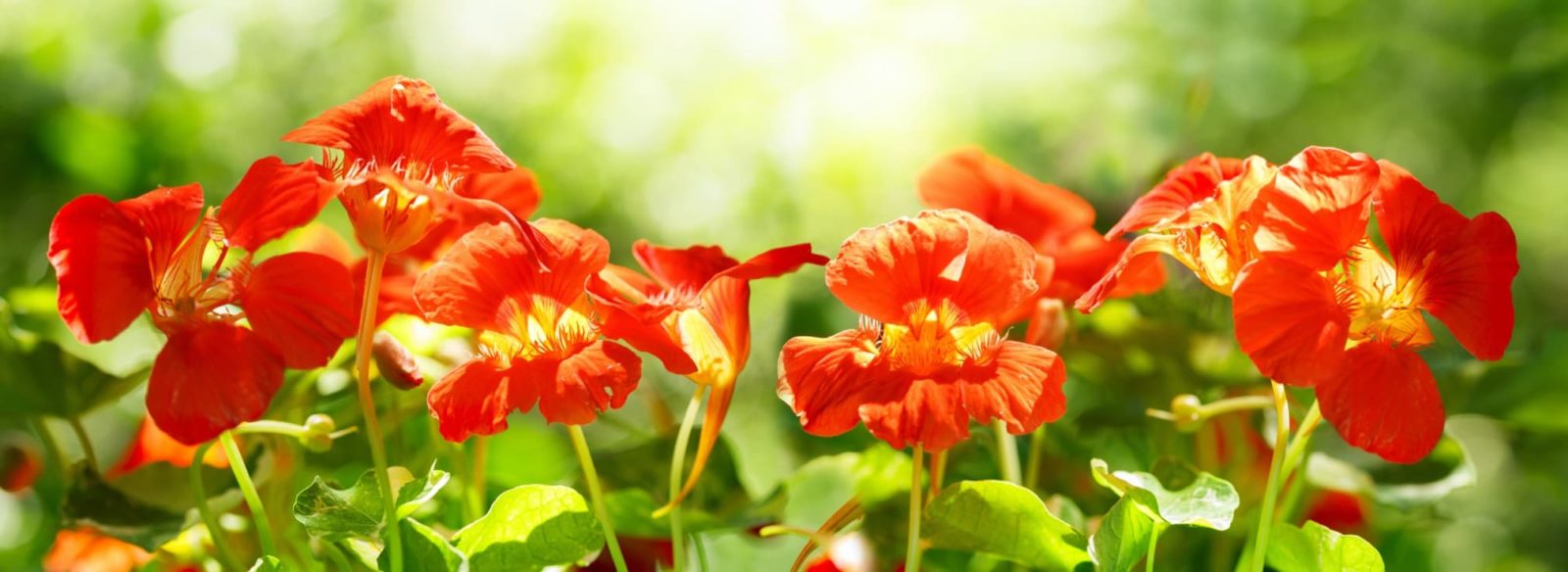
ANNUALS > NASTURTIUM
Reviewed By COLIN SKELLY

Colin is a Horticulturist and Horticultural Consultant with experience in a range of practical and managerial roles across heritage, commercial and public horticulture. He holds the Royal Horticultural Society’s Master of Horticulture award and has a particular interest in horticultural ecology and naturalistic planting for habitat and climate resilience.
Contributions From HANNAH REID
IN THIS GUIDE
NASTURTIUM GUIDES
Companion Planting
Container Growing
Indoors Growing
Sowing
Varieties
Tropaeolum, commonly called Nasturtium, is a genus of climbing, sometimes creeping, plants that have fantastic ornamental value in terms of their heights and spreads, foliage and flowers.
These rather unusual plants typically have a very long blooming season, and their flowers come in an astonishing variety of colours from icy blue to blazing red.
“I grow nasturtiums every year,” says Gardener Hannah Reid.
“I love nasturtiums for their beautiful flowers and leaves. An additional bonus is that the entire plant is edible – flowers, foliage and seeds, which are amazing pickled!”
It is not to be confused with Genus Nasturtium which encompasses Cress species.
Nasturtiums are unusual plants on several counts:
- First, most of them are resilient, if not always strong, climbers though a few have a bushy, spreading habit.
- Second, their foliage is both uncommon and attractive.
- Third, their brilliant flowers are even more attractive; what’s more, they bloom for months on end.
- Fourth, they are very low-care plants.
- Fifth, they are effective companion plants to a whole host of edible plants.
Taxonomically there is a connection to the abovementioned Cress because both Genus Tropaeolum (‘Nasturtium’) and Genus Nasturtium (Cress) fall under Order Brassicales, many of whose members are edible and which have a tangy, peppery, or pungent flavour, with Mustard probably being the ‘Head of the Family’.1Nasturtium (water-cress). (n.d.). Native Plant Trust: Go Botany. Retrieved March 21, 2023, from https://gobotany.nativeplanttrust.org/genus/nasturtium/
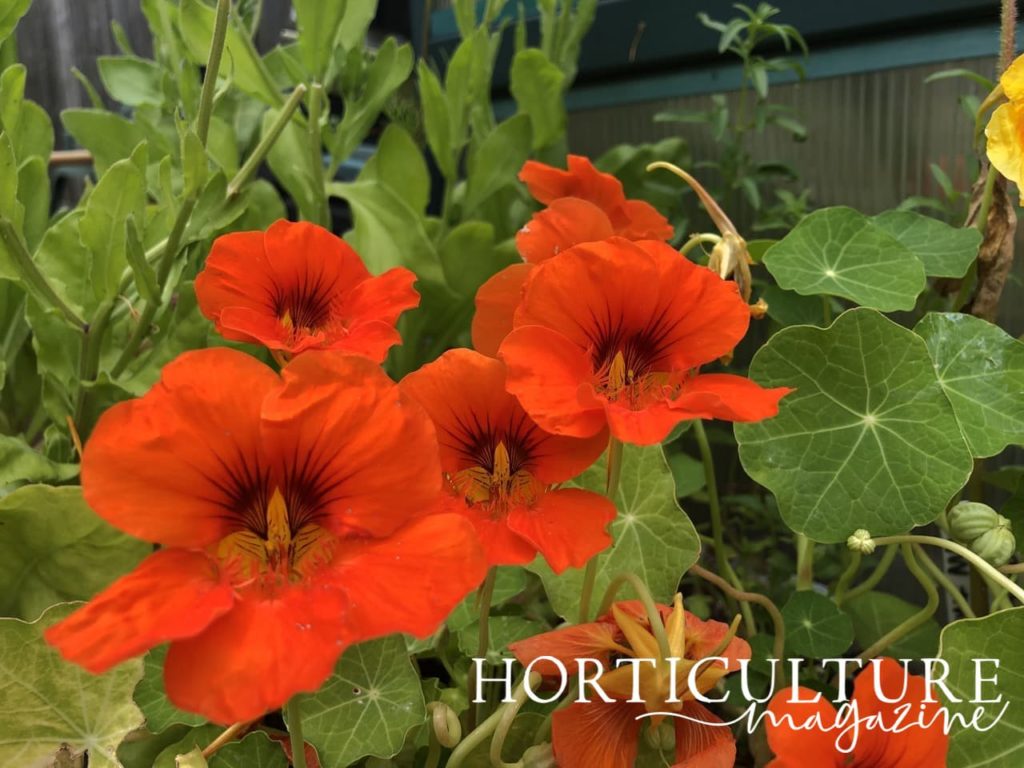
As it happens, Nasturtium flowers and leaves are edible and lend a piquant zing to salads and even soups.
Out of Rocket? Not a problem if you have a Nasturtium in the garden.
Overview
| Botanical Name | Tropaeolum majus |
| Common Name(s) | Nasturtium |
| Plant Type | Annual Flower / Climber |
| Native Area | South & Central America |
| Hardiness Rating | H3 |
| Foliage | Deciduous |
| Flowers | Commonly red, yellow or orange |
| When To Sow | March, April, May |
| Flowering Months | July, August, September, October |
Sunlight
Preferred
Full Sun
Exposure
Exposed or Sheltered
Size
Height
1.5 – 2.5M
Spread
1.5 – 2.5M
Bloom Time
July – October
Soil
Preferred
Chalk, loam, sand
Moisture
Well drained
pH
Any
Though Nasturtiums are deciduous perennials, in most regions of the United Kingdom they are half-hardy and are grown as annuals.
However, along the south-western coast and a few other regions, several varieties can be grown as the perennials that they are (though a few varieties, such as T. tuberosum and T. speciosum, can be grown as perennials in almost all regions of the UK).
If you are lucky enough to call a relatively balmy region home, you can bring great joy to your garden by growing arguably the most ornamental of all climbers.

To begin with, the foliage is of a mellow sea-green colour.
The leaves are decorative in their own right, being either lobed, often deeply, or rounded and shield-shaped.
The showy flowers come in hues of yellow, orange and red, but a few are in shades of blue and purple and some are also bi-coloured or variegated.
To top it all off, Nasturtiums bloom for months on end, many varieties are fragrant, and the flowers attract butterflies and hummingbirds!
Habitat & Growing Conditions
Tropaeolum grow in the wild from south-eastern Mexico and Guatemala in the north to the tip of Patagonia in the south, excluding Brazil.
Some species grow at altitude in the alpine regions of the Andes while others grow in lowland coastal areas; Chile is a particular centre of species diversity.2Tropaeolum majus. (n.d.). Kew Royal Botanic Gardens. Retrieved March 21, 2023, from https://powo.science.kew.org/taxon/urn:lsid:ipni.org:names:310974-2

What is common to all of them is that they are indifferent to soil – as they grow in soils ranging from average down to what can only be typically considered very poor.
They are usually found growing in full sun; though their water needs are low they do best in moist soil.
The vast majority of Nasturtium species are frost-tender and are hardy (only) to Zone H3.
A few species, though, are frost-hardy down to Zone H5.

Planting
Most Nasturtiums are climbers that attain heights of about 3m.
A few, such as T. speciosum and T. peregrinum, can reach heights of up to 4m.
An overgrown Nasturtium climber along the wall of a house will impart a charming, country-cottage effect to your urban dwelling.
They will produce the same countryside charm when they climb up and wash over boundary walls and fences with next to no training.
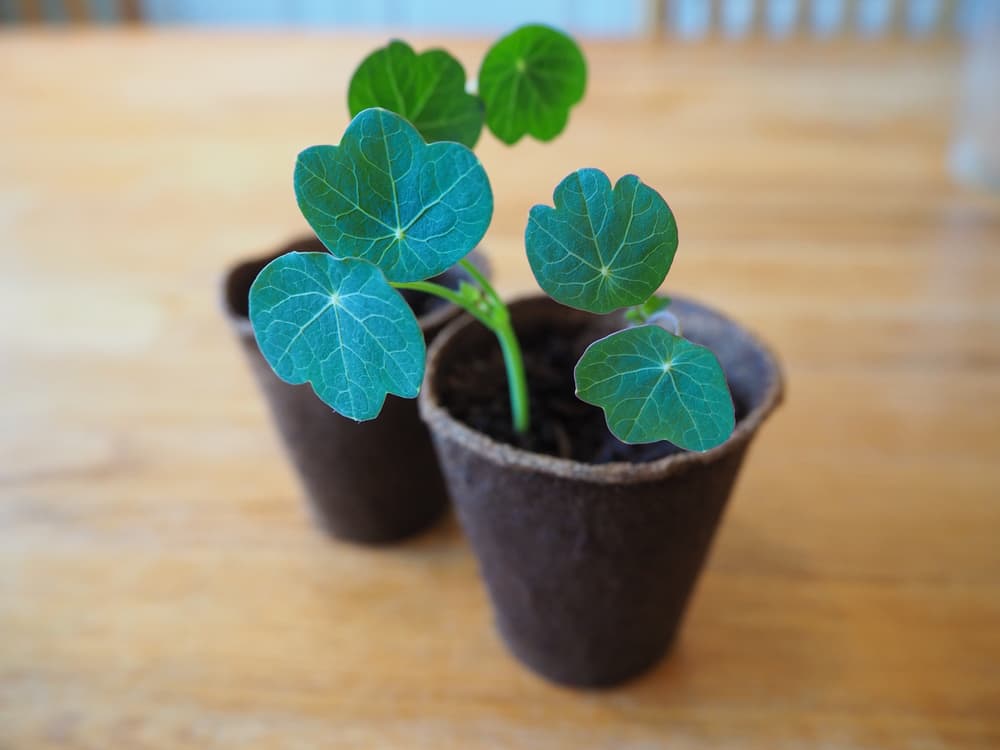
The shorter, more delicate, Nasturtiums, for example T. azureum, are ideal to plant beside summer-houses, especially when the walls are of latticework – then a few flowers and leaves will ‘peek’ inside.
Some Nasturtiums have a spreading, bushy habit. Examples include T. majus ‘Empress of India’ and T. majus ‘Chameleon’.
If grown in large planters these species will add great colour and produce a delightful billowing effect by the patio or on the porch.
They can actually be used to create borders as well.
How To Grow Nasturtiums
Nasturtium seeds of the spreading, trailing varieties, are widely available at nurseries and online stores.
In addition, seeds of the more popular climbers, for example T. speciosum, are just as freely found.
Some, such as T. majus ‘Chameleon’, are much harder to find.
Because species of this genus do not take well at all to transplanting, only a few varieties, such as the bushy, spreading varieties, are available as plants in containers from a limited number of garden centres.
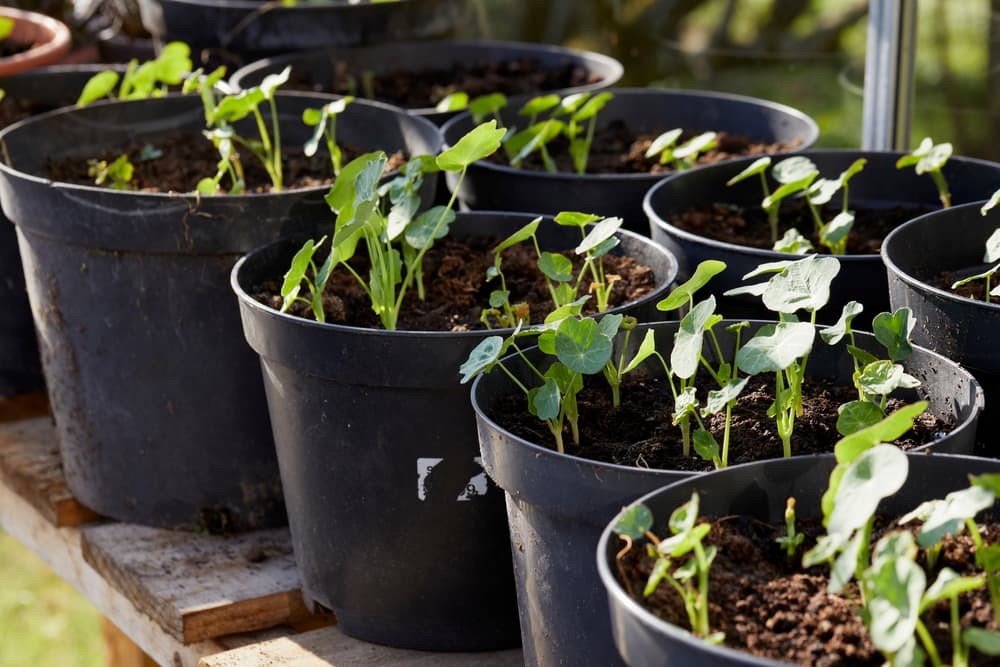
If you already have a Nasturtium, you may be able to get new Nasturtiums for yourself and your friends.
Some species self-seed very reliably. You can often simply let the flowers wither and then harvest the seed pods.
Plant Care
Most, if not all, Tropaeolum varieties can be grown reliably from (the rather large) seeds.
One may as well add that they will just as reliably start to wilt and wither if transplanted.
Therefore, do not start these plants in pots for later transplanting though you may very much grow and keep short and spreading varieties in planters.
Soil Requirements
Besides being very transplanation-averse, these plants have yet another quirk.
They do best in poor soil! The richer the soil, the more foliage they will produce at the expense of flowers.
A mix of gravel, chalk, and sand with but a sprinkling of humus or manure mixed in will be perfect though any old soil will do.

Soil pH hovering around neutral is ideal though any pH from moderately acidic to slightly alkaline will do fine for most Tropaeolum varieties.
The one non-negotiable is that soil should drain very well.
Watering
These plants should be watered about twice a week, be it from the rains or the hosepipe.
When the soil dries out, it is time to water them.
Younger plants need more regular watering than established outdoor ones.
Feeding
Avoid fertilising Nasturtiums of any kind.
Nitrogen-high fertiliser especially should be avoided because it will spur growth of foliage on an already leafy plant; in turn, this will negatively affect the number and size of blooms.

Indeed, even a balanced fertiliser would not be a smart idea for Nasturtiums under most circumstances.
Overwintering
If you have grown a Nasturtium as a perennial in the UK, then, if it is of a type that is dormant in winter and is not frost-hardy (the majority of varieties), soon after the leaves have shed in autumn, you should spread a layer of leaf mulch on the soil above the root system.
Remove it a couple of weeks after the last frost of winter.
Pruning
In general Nasturtiums do not need to be pruned as they are deciduous plants (assuming you can grow them as perennials and not as annuals).
“Nasturtiums are so vigorous that, unless you are happy for them to be rampant, you will need to cut back the stems,” shares Horticultural Consultant Colin Skelly.
“Just cut back stems to just above a leaf and your Nasturtium will happily keep growing around whichever area you want clear.”
In general, the bushy spreading varieties may be cut back soon after the flowering season is over.
Climbing varieties can be deadheaded to encourage fresh blooms.

Don’t get caught out by the flowering season and dormancy season of your Nasturtium variety; keep in mind that T. azureum, T austropurpureum, and T. tricolor are all dormant during the summer and bloom in winter and spring.
Common Problems
Tropaeolum is an inherently healthy genus and is known to stay free of disease but the different varieties have varying susceptibilities to pests.
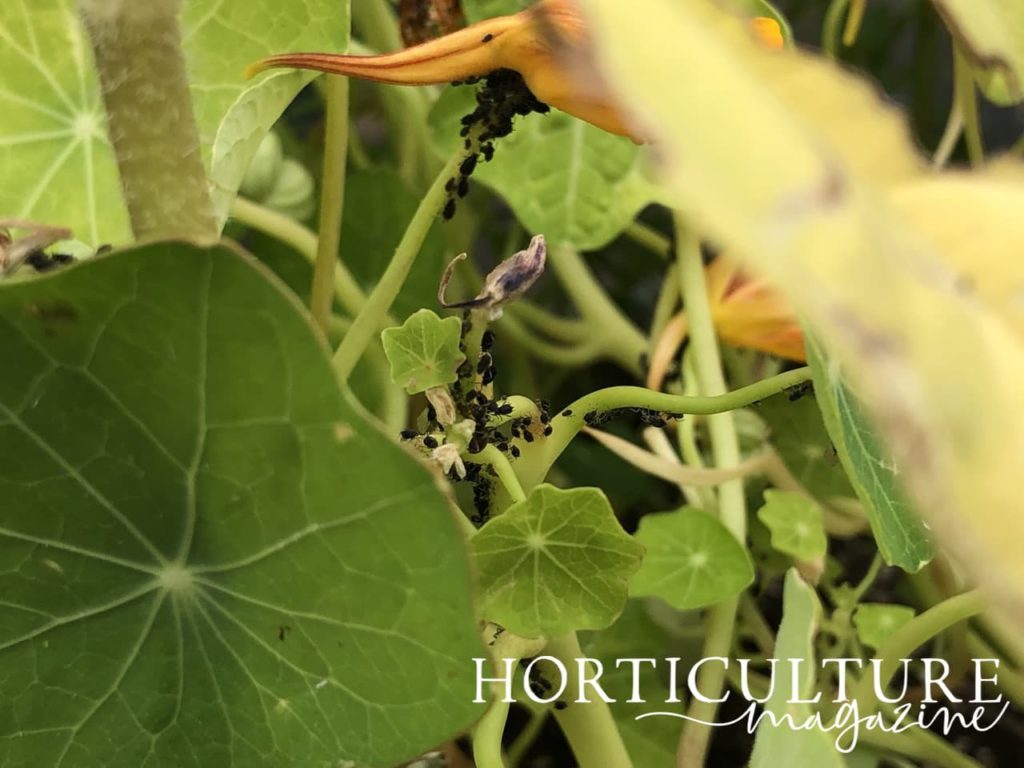
In general, the shorter Chilean climbers are the most robust while T. majus and its varieties are the least robust.
Both T. speciosum and T. peregrinum may be attacked by flea beetles and caterpillars with the former also a target for blackfly and the latter for aphids.
T. majus and its cultivars are susceptible to blackfly, flea beetles, and caterpillars, in addition to which a lesser threat is posed by slugs.
References
- 1Nasturtium (water-cress). (n.d.). Native Plant Trust: Go Botany. Retrieved March 21, 2023, from https://gobotany.nativeplanttrust.org/genus/nasturtium/
- 2Tropaeolum majus. (n.d.). Kew Royal Botanic Gardens. Retrieved March 21, 2023, from https://powo.science.kew.org/taxon/urn:lsid:ipni.org:names:310974-2


